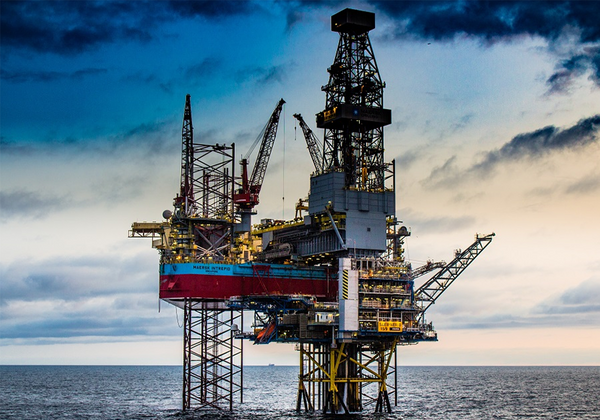
Danish drilling contractor Maersk Drilling's Maersk Intrepid jack-up drilling unit, recently converted to a hybrid, low-emission rig, has in its first month of operation since the upgrade, seen its CO2 emissions drop by 25%, and NOx by 95%, according to the rig owner.
The Maersk Intrepid is currently working for Equinor on the Martin Linge field offshore Norway where the ultra-harsh environment jack-up in November this year began its first drilling operation with the full low-emission package in use.
According to Maersk Drilling, the full technology package was expected to deliver a double-digit energy savings potential.
This, Maersk Drilling says, has now been confirmed on Maersk Intrepid where the first month of operations on Martin Linge produced an initial data point of reducing fuel consumption and CO2 emissions by approximately 25% compared to the baseline average for the rig.
In addition, NOx emissions were reduced by approximately 95%, an improvement from the original target of 90%.
The installation of low-emission technology is one of several initiatives that support Maersk Drilling’s efforts to reach the company’s recently announced target of reducing its CO2 emissions intensity by 50% by 2030. Other initiatives relating to CO2 reductions include operating rigs on shore power and participation in the Project Greensand consortium which is targeting the use of discontinued oil and gas fields for permanent storage of CO2 offshore Denmark, Maersk Drilling said.
Commenting on the first results from the Maersk Intrepid, Caroline Alting, Head of Integrity & Projects, Maersk Drilling: “We’re thrilled to now see the full complement of low-emission technology in use on Maersk Intrepid, and to receive a very promising first dataset on emission reductions.
"It’s still too early to make any definitive conclusions on average emission reductions over time, but the preliminary results are very promising with reductions around 25% compared to the rig’s baseline, driven by both energy-saving technology and behavioral changes supported by the low-emission package.
"We want to do our part in the transition towards a sustainable energy future, and we’re thankful for the engagement of our customer Equinor and the NOx Fund in realising this project."
Incentives
The hybrid, low-emission upgrades installed on Maersk Intrepid are supported by a grant from the Norwegian NOx Fund and by Equinor’s decision to introduce compensation formats to stimulate emission reductions. The upgrades combine the use of hybrid power with NOx conversion units, adding data intelligence to further reduce energy consumption and CO2 emissions. As part of the Master Frame Agreement between Maersk Drilling and Equinor, the parties have committed to exploring further initiatives to limit greenhouse gas emissions from drilling operations.
The full package of hybrid, low-emissions upgrades is also being installed on the ultra-harsh environment jack-up rig Maersk Integrator which is expected to start operating in full low-emission mode in early 2021 in Norway.
“Maersk Drilling shows that it is technically and financially feasible to retrofit offshore rigs with low-emission solutions. It is also important that the ambitions do not stop there, but, as in this case, that the new technology opens for further reductions towards a zero-emission future.
"If Norway is to meet its national emission targets, it is crucial that offshore rigs contribute with their share, and with the improvements on Maersk Intrepid, Maersk Drilling is showing the way. The NOx Fund is ready for more applications of similar character and hopes that rig operators and entrepreneurs together can develop new projects,” says Tommy Johnsen, General Manager of the NOx Fund.
The rig, and the tech
Maersk Intrepid is an ultra-harsh environment CJ70 jack-up rig, designed for year-round operations in the North Sea. It was delivered in 2014 and has been operating in Norway ever since.
The low-emission package for Maersk Intrepid and Maersk Integrator consists of three upgrades in total:
Hybrid power
The energy use onboard a rig is characterized by high peak loads during certain operations. By installing energy storage by use of batteries, basic energy requirements can be met by fewer engines operating at a higher intensity, supplemented by battery power – which is both more efficient and reduces CO2 and NOx emissions. The energy storage system also allows for recovery of the braking energy which adds to energy savings and further reduces emissions.
Energy Emission Efficiency software
The cloud-based Energy Emission Efficiency (EEE) software developed by Maersk Drilling uses real-time data to monitor energy use on board the rig, which allows for continuous optimisation, for example by switching off engines when they are not needed. The input from the EEE system can further be used to increase focus on energy-saving behavioural changes in general.
SCR units to reduce NOx emissions
Selective Catalytic Reduction (SCR) systems capture NOx exhausts and use ammonia injections to convert the gas into harmless water and nitrogen. On Maersk Intrepid, the systems have reduced NOx emissions by approximately 95%, an improvement from the original target of 90%.